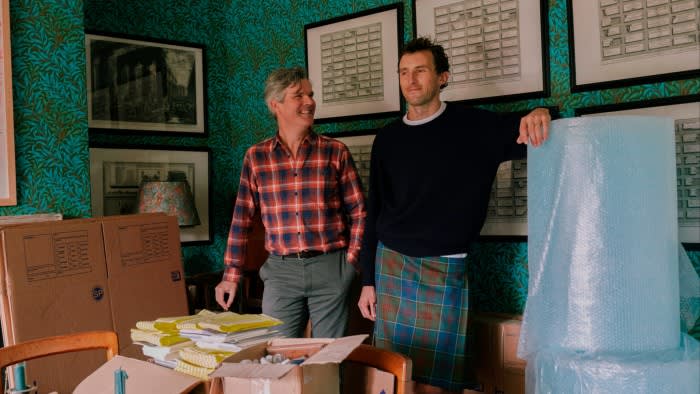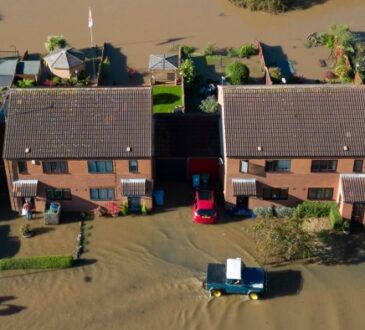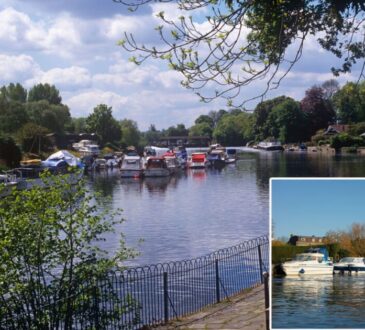
We got the letter from our landlords five years ago; the first clue that there were seismic changes afoot. We had enjoyed a wonderful lease with a 10-year duration on the Old Parsonage: perched on the side of a wooded valley, in the tiny, thatched hamlet of Littlebredy, the estate village to the Bridehead Estate in Dorset. Surrounded by chalk hills, it felt like a magical lost kingdom, like the setting of Love on a Branch Line, a place that time forgot.
It has been home for the last 15 years. My husband Charlie McCormick and I were married in the church, and my mother is buried there. Charlie made a wonderful garden. We put down roots. Every five years, with the informal agreement of our landlords, we’d re-set the lease back to 10 — a benign arrangement that gave us, and them, just as much certainty as we needed — for, after all, who knows where they will be in 10 years’ time? In 2019, we asked to do the same again. Initially, the answer from the land agent had been yes, but when, having heard nothing, we followed up, we were told that the family were deliberating the future, and no longer wished to have long leases in the village. I remember walking down the valley that morning with Charlie and the dogs, knowing that our time here was going to come to an end.
Of course, the first rule of being a tenant is that you must gladly accept this. It’s not your house! (It does, actually, belong to your landlord. If they want it back, or to do something different, well — that’s life). When I wrote an article for the Financial Times a decade ago — a paean to renting not owning — I extolled the virtues of having a long-term lease with an institutional landlord. It is something that I still passionately believe we need more of if we are to reframe the tortured relationship between private ownership and long-term rental in the UK. I had written then about the fact that as a designer I could just about afford to rent a flat in London and this beautiful house in Dorset — whereas if I was trying to make a mortgage work, with huge deposits and all the rest, there’s simply no way that it would have been possible. My argument centred on the need for these long-term landlords, whose main aim is not to achieve the highest rent (with an equally high turnover of tenants) but to secure good, longer-term tenancies and to find people who will look after their buildings and contribute to the communities in which they live. Nothing felt more certain.

But the wheels of time continue to turn, and the family who have been our landlords did then take the very personal decision to sell their estate, as we’d expected. I imagine that a few readers of this article may even have visited — for it truly was the sale of the century — one of the most magical of all of Dorset’s landed estates, being sold as a single-lot sale for the first time in hundreds of years. As I write, a sale seems to be progressing, and the village waits for news of a new owner. Whoever it may be, change is on the way — a change we decided we didn’t want to stay for, as we loved the old ways too much. We went house-hunting.
A decade ago, I never imagined I’d say those words — not least, because I so firmly tied myself to the mast of tenancy. (It’s true that a few years ago, we did buy a tiny and derelict bothy on the far west coast of Scotland, in mid-Argyll, but one of the things about derelict houses is that you are unable to take a mortgage on them, so I still felt true enough to my own rather loudly-stated principle). But as the tectonic plates in Dorset shifted, we decided that maybe we did need to find a place where such a change could never happen again.
Maybe it’s the fact that I’m no longer in my thirties, and now realise how quickly a decade passes? What seemed an age then, now, 20 years later, goes by in a flash. Or maybe it was a yearning, on both Charlie’s and my part, to have more security in life, when the place we thought we’d live in forever was suddenly no longer as permanent as it had seemed.
Like some migratory birds in the spring, we also had an unspoken urge to move north. The crowded south of England, the endless hum of traffic, is something I am increasingly losing patience for. I am under no illusions that we are all part of the problem, but we couldn’t wait to move to an emptier, more rugged place. As the world headlines tip deeper into chaos and confusion, I think we are not alone in that sense of wanting to find a more private peace.

We looked at houses in Cumbria, Northumberland and the Scottish borders. Nothing was quite right. As time went on, we became increasingly despondent. But this summer, I was scrolling (as I did very often) through Rightmove and saw a little photo of our dream house. I clicked on the link. It was in Orkney. I clicked further. I sent it to Charlie. “This is not very easy to get to”, my message read, “but it’s perfect”. “IT’S THE ONE” came back his reply. The following weekend we made a new journey in our lives, to the tiny island of Rousay, to see Westness House — and we fell in love.
Here was a beautiful 18th-century building, four-square and plain, with crowstepped gables, surrounded by a 10-acre walled garden and woods, facing south-west over the sea. In the 19th century, the house was decorated with papers by William Morris, and the fireplaces fitted with tiles by the English designer, William De Morgan. The garden walls are 10ft high, and the garden is filled with ancient sycamores, giving a sense of shelter and enclosure from the powerful Orcadian winds and storms. At the bottom of the garden was a tiny, still-consecrated chapel (although we have yet to find a serving vicar). The land runs down to a beach.
Somehow the house was waiting for us, and we had been waiting for it. We spent two days exploring some of the wider joys of Orkney, before going back to Westness, where the feeling of rightness was deeper still in our bones. We placed an offer, and it was accepted (the beauty of the Scottish system is that at this point, we are in a legally binding contract). And so, as you read this newspaper, Charlie and I are on the long road north, having packed up and left Dorset, with an army of pantechnicons making a crazy journey to a remote island, involving hundreds of miles of driving and two ferries. Here we will be, on the edge of this tiny island (population c.225), facing west over the Atlantic — with nothing beyond us until Newfoundland and Labrador.

So how do I square this with my loud pronouncement about never buying a house? I can’t deny the impact that the shifts in Littlebredy have made — a realisation that maybe it was time to break my golden rule. There was that elegiac sense of loss that I think anyone who has had a long-term tenancy come to an end will sympathise with; you only need to read Cecil Beaton’s brilliant Ashcombe: the Story of a Fifteen Year Lease, (which describes the fabled house which he rented and restored in 1930s Wiltshire) to understand that. But unlike Cecil, we hold no malice at our departure. We just feel happiness at the 15 incredible years we had. It is a place we will never forget, but we are content to be leaving and starting a new adventure.
In the broadest sense, I remain convinced that a thriving rental sector is key to a happy housing market. Not everyone needs to own a house, or run a mortgage, to be happy — as I hope I proved well enough, for the first 30 years of my working life. Continental models, where private ownership is far lower than in England, have always felt attractive to me. In the UK, surely it must be time for the financial institutions to step in and build a huge portfolio of good new homes for long-term tenants who either cannot afford to buy, or who do not want to be chained to a mortgage forever. But the new (and previous) governments’ so called “war on private landlords” seems relentless. There is an underlying sense that all landlords are all evil — but life is made particularly hard for them now, with new standards and targets. The floated changes to capital gains tax will surely mean many leaving the sector immediately, and I cannot imagine what the new energy ratings will mean for tenancies in villages like Littlebredy, filled with old but unlisted buildings which will soon become almost unlettable, impossible as it will be to upgrade them to the right energy rating and still receive a commercial return. Never was it truer that the road to hell was paved with good intentions.
My other rant, back then, was about mortgages. As we slip out of the era, probably forever, of the weird world of zero-interest rates, many are waking up harshly to the realities of how much mortgages really cost. Young people in my office now are taking on 30- or 40-year repayment periods. Compound interest means that they better hope the value of their houses doubles every 20 years, as middle-class people used to boast at dinner parties, because they are all certainly paying that much. Stamp duty alone would cover several years rent for many people. You may think your house is your castle, but in most cases it actually belongs to the bank — and by the time you’ve bought it off them, you’ve paid an astounding amount in interest repayment.


This is what I found so terrifying, 20 years ago. I was horrified by the idea of sucking up all my fun into saving for a deposit, a mountain whose summit could never quite be reached even back then — in order to take out a huge loan for the rest of my life. It felt like a bad place to put my energy. There was no way on earth I could have afforded to buy the Old Parsonage — but I could, quite easily as it happened, afford to rent it.
So all I can say here is that we have done a strange thing, by waiting, and waiting (and saving along the way) — and by buying a house with only a small mortgage. To do this, we have admittedly gone to an impossibly remote place where we can actually afford to live in a home we love, without being in debt for ever. Of course, heading far from the magnet of London, and the overpriced south, cannot be for everyone, but like many in the post-Covid era, I will be learning new ways of working that seemed inconceivable 10 years ago — combining working from home with less regular commuting to the office. Charlie will be in Rousay full time, with our animals and his new garden; for a while, I’ll be like an oil-rig worker — two weeks away, one week at home. We live in a time of huge mobility. We’re by no means alone in using that to our advantage; and by heading to the remotest reaches, our dream house has cost us hundreds of thousands, and not many millions, of pounds.

Maybe we’re wrong — in which case, I will be first to eat humble pie. I have no doubt that I’ll have many a cancelled flight (on the tiny propeller planes of Loganair) at Kirkwall airport, heading south to work. I am sure many of our new neighbours will be speculating whether we’ll survive two or three long Orcadian winters.
But there’s something about this place that calls us: the peace and solitude of these ancient islands, filled with their history, archaeology, nature, yet still bursting with modern life and a powerful sense of community, that is irresistible — and which allow us, at last, to say this is the place we may call home forever.
‘An English Vision: Traditional Architecture and Decoration for Today’ by Ben Pentreath is published by Rizzoli International Publications (www.pentreath-hall.com)
Find out about our latest stories first — follow @ft_houseandhome on Instagram




